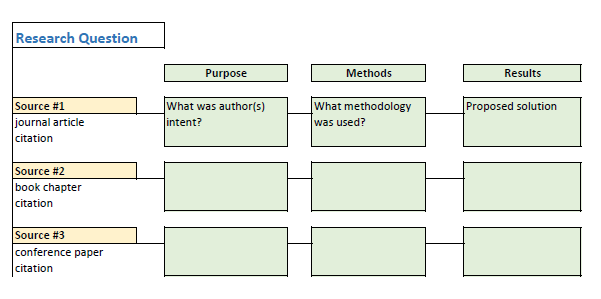Learning Objectives
- Connect the sources you read with key concepts in your research question and proposal
- Systematize the information and facts from each source you read
Putting the pieces together
Combining separate elements into a whole is the dictionary definition of synthesis. It is a way to make connections among and between numerous and varied source materials. A literature review is not an annotated bibliography, organized by title, author, or date of publication. Rather, it is grouped by topic and argument to create a whole view of the literature relevant to your research question.
Your synthesis must demonstrate a critical analysis of the papers you collected, as well as your ability to integrate the results of your analysis into your own literature review. Each source you collect should be critically evaluated and weighed based on the criteria from Chapter 3 before you include it in your review.
Begin the synthesis process by creating a grid, table, or an outline where you will summarize your literature review findings, using common themes you have identified and the sources you have found. The summary, grid, or outline will help you compare and contrast the themes, so you can see the relationships among them as well as areas where you may need to do more searching. A basic summary table is provided in Figure 4.2. Whichever method you choose, this type of organization will help you to both understand the information you find and structure the writing of your review. Remember, although “the means of summarizing can vary, the key at this point is to make sure you understand what you’ve found and how it relates to your topic and research question” (Bennard et al., 2014, para. 10).

Figure 4.2 Summary table
As you read through the material you gather, look for common themes as they may provide the structure for your literature review. And, remember, research is an iterative process. It is not unusual to go back and search academic databases for more sources of information as you read the articles you’ve collected.
Literature reviews can be organized sequentially or by topic, theme, method, results, theory, or argument. It’s important to develop categories that are meaningful and relevant to your research question. Take detailed notes on each article and use a consistent format for capturing all the information each article provides. These notes and the summary table can be done manually using note cards. However, given the amount of information you will be recording, an electronic file created in a word processing or spreadsheet is more manageable. Examples of fields you may want to capture in your notes include:
- Authors’ names
- Article title
- Publication year
- Main purpose of the article
- Methodology or research design
- Participants
- Variables
- Measurement
- Results
- Conclusions
Other fields that will be useful when you begin to synthesize the sum total of your research:
- Specific details of the article or research that are especially relevant to your study
- Key terms and definitions
- Statistics
- Strengths or weaknesses in research design
- Relationships to other studies
- Possible gaps in the research or literature (for example, many research articles conclude with the statement “more research is needed in this area”)
- Finally, note how closely each article relates to your topic. You may want to rank these as high, medium, or low relevance. For papers that you decide not to include, you may want to note your reasoning for exclusion, such as small sample size, local case study, or lacks evidence to support conclusions.
An example of how to organize summary tables by author or theme is shown in Table 4.1.
Table 4.1: Summary table | Author/Year | Research Design | Participants or Population Studied | Comparison | Outcome |
| Smith/2010 | Mixed methods | Undergraduates | Graduates | Improved access |
| King/2016 | Survey | Females | Males | Increased representation |
| Miller/2011 | Content analysis | Nurses | Doctors | New procedure |
For a summary table template, see blogs.monm.edu/writingatmc/files/2013/04/Synthesis-Matrix-Template.pdf
Creating a topical outline
An alternative way to organize your articles for synthesis it to create an outline. After you have collected the articles you intend to use (and have put aside the ones you won’t be using), it’s time to extract as much as possible from the facts provided in those articles. You are starting your research project without a lot of hard facts on the topics you want to study, and by using the literature reviews provided in academic journal articles, you can gain a lot of knowledge about a topic in a short period of time.

As you read an article in detail, I suggest copying the information you find relevant to your research topic in a separate word processing document. Copying and pasting from PDF to Word can be a pain because PDFs are image files not documents. To make that easier, use the HTML version of the article, convert the PDF to Word in Adobe Acrobat or another PDF reader, or use “paste special” command to paste the content into Word without formatting. If it’s an old PDF, you may have to simply type out the information you need. It can be a messy job, but having all of your facts in one place is very helpful for drafting your literature review.
You should copy and paste any fact or argument you consider important. Some good examples include definitions of concepts, statistics about the size of the social problem, and empirical evidence about the key variables in the research question, among countless others. It’s a good idea to consult with your professor and the syllabus for the course about what they are looking for when they read your literature review. Facts for your literature review are principally found in the introduction, results, and discussion section of an empirical article or at any point in a non-empirical article. Copy and paste into your notes anything you may want to use in your literature review.
Importantly, you must make sure you note the original source of that information. Nothing is worse than searching your articles for hours only to realize you forgot to note where your facts came from. If you found a statistic that the author used in the introduction, it almost certainly came from another source that the author cited in a footnote or internal citation. You will want to check the original source to make sure the author represented the information correctly. Moreover, you may want to read the original study to learn more about your topic and discover other sources relevant to your inquiry.
Assuming you have pulled all of the facts out of multiple articles, it’s time to start thinking about how these pieces of information relate to each other. Start grouping each fact into categories and subcategories as shown in Figure 4.3. For example, a statistic stating that homeless single adults are more likely to be male may fit into a category of gender and homelessness. For each topic or subtopic you identified during your critical analysis of each paper, determine what those papers have in common. Likewise, determine which ones in the group differ. If there are contradictory findings, you may be able to identify methodological or theoretical differences that could account for the contradiction. For example, one study may sample only high-income earners or those in a rural area. Determine what general conclusions you can report about the topic or subtopic, based on all of the information you’ve found.
Create a separate document containing a topical outline that combines your facts from each source and organizes them by topic or category. As you include more facts and more sources into your topical outline, you will begin to see how each fact fits into a category and how categories are related to each other. Your category names may change over time, as may their definitions. This is a natural reflection of the learning you are doing.
Table 4.2 Topical outline | Facts copied from an article | Topical outline: Facts organized by category |
- A complete topical outline is a long list of facts, arranged by category about your topic. As you step back from the outline, you should understand the topic areas where you have enough information to make strong conclusions about what the literature says. You should also assess in what areas you need to do more research before you can write a robust literature review. The topical outline should serve as a transitional document between the notes you write on each source and the literature review you submit to your professor. It is important to note that they contain plagiarized information that is copied and pasted directly from the primary sources. That’s okay because these are just notes and are not meant to be turned in as your own ideas. For your final literature review, you must paraphrase these sources to avoid plagiarism. More importantly, you should keep your voice and ideas front-and-center in what you write as this is your analysis of the literature. Make strong claims and support them thoroughly using facts you found in the literature. We will pick up the task of writing your literature review in section 4.3.
Additional resources for synthesizing literature
There are many ways to approach synthesizing literature. We’ve reviewed two examples here: summary tables and topical outlines. Other examples you may encounter include annotated bibliographies and synthesis matrixes. As you are learning research, find a method that works for you. Reviewing the literature is a core component of evidence-based practice in social work at any level. See the resources below if you need some additional help:
Literature Reviews: Using a Matrix to Organize Research / Saint Mary’s University of Minnesota
Literature Review: Synthesizing Multiple Sources / Indiana University
Writing a Literature Review and Using a Synthesis Matrix / Florida International University
Sample Literature Reviews Grid / Complied by Lindsay Roberts
Killam, Laura (2013). Literature review preparation: Creating a summary table. Includes transcript. https://www.youtube.com/watch?v=nX2R9FzYhT0
Key Takeaways
- It is necessary to take notes on research articles as you read. Try to develop a system that works for you to keep your notes organized, such as a summary table.
- Summary tables and topical outlines help researchers synthesize sources for the purpose of writing a literature review.
Image attributions
Pieces of the puzzle by congerdesign CC-0
Adult diary by Pexels CC-0
|





